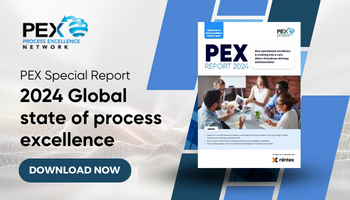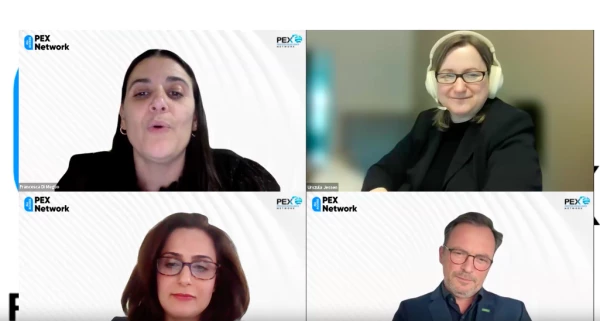A summary of Gartner’s 2024 Magic Quadrant for Process Mining Solutions
Process mining is integral to adapting to uncertainties and driving transformation at speed and scale
Add bookmark
The Magic Quadrant for Process Mining Platforms is a comprehensive report from analyst firm Gartner that evaluates process mining technology vendors to help organizations in their selection processes. It also examines how the process mining market is evolving and outlines the main drivers of process mining adoption.
This year’s report, published last week, groups 18 vendors into four categories – challengers, leaders, niche players and visionaries – with vendors placed on two axes: the ability to execute and completeness of vision. These axes reflect numerous criteria that measure each vendor’s performance and its future vision, with Gartner outlining strengths and cautions (potential weaknesses) for each vendor. The paper lists an additional 10 vendors as honorable mentions.
Don't miss any news, updates or insider tips from PEX Network by getting them delivered to your inbox. Sign up to our newsletter and join our community of experts.
Gartner defines process mining platforms as platforms that are designed to discover, monitor and improve processes by extracting knowledge from events captured in information systems to continuously deliver visibility and insights.
“Process mining includes automated process discovery (extracting process models from an event log), conformance checking (monitoring deviations by comparing model and log), social network/organizational mining, automated construction of simulation models, model extension, model repair, case prediction and history-based recommendations,” the firm adds. Process mining platforms extend process mining capabilities by advanced process analytics, process improvement detection and process improvement recommendations, partly driven by AI and generative AI.
By 2026, 25 percent of global enterprises will have embraced process mining platforms as a first step to creating a digital twin for business operations, paving the way to autonomous business operations, according to Gartner. “Process mining has become an essential enterprise solution for adapting to an uncertain world and driving transformation at speed and scale,” says Daniel de Rooij, SVP digital transformation and CIO at Reckitt, a global consumer products company with well-known brands such as Finish dishwasher tablets, Lysol disinfectant and Nurofen painkillers.
Here is a summary of the 2024 Magic Quadrant for process mining with reaction and commentary from thought and business leaders in the process mining field.
READ: What is process mining?
Process mining leaders
Gartner identifies nine vendors as process mining leaders – companies with deep understanding of market realities, a track record of success and an ability to influence the market’s direction, along with an ability to attract and keep a growing customer base. The nine vendors are:
- ABBYY: Strengths – document and text data, execution and offering. Cautions – generative AI, customer experience and verticals/industry strategy.
- Appian: Strengths – market positioning, innovation and process execution and orchestration. Cautions – automation use case, business activity monitoring and customer experience.
- Apromore: Strengths – ease of use, innovation and task mining. Cautions – deployment, geographic strategy and verticals.
- Celonis: Strengths – execution, innovation and marketing strategy. Cautions – pricing, customer experience and task mining.
- MEHRWWERK: Strengths – market vision, innovation and data access and management within a platform. Cautions – geographies, BI platform and process orchestration.
- Microsoft: Strengths – advanced analytics, task mining and generative AI. Cautions – partner support, on-premises deployment and object-centric process mining (OCPM) support.
- SAP Signavio: Strengths - market positioning and vision, innovation and SAP client ecosystem. Cautions – pricing, SAP focus and marketing execution.
- Software AG: Strengths – process orchestration, generative AI and customer experience. Cautions – non-ARIS clients, task mining and marketing execution.
- UiPath: Strengths – market positioning, execution support and automation. Cautions – automation use case, OCPM and advanced analytics.
“In the process mining platform market, leaders understand, facilitate and support the diversity of use cases (operational excellence, audit and compliance, automation, digital transformation, strategy to execution and customer excellence),” Gartner states. Leaders also add other functionality, products and services to core process mining offerings, it adds.
Commenting on Celonis’ inclusion in the leaders category, Alex Rinke, co-CEO and co-founder of Celonis, says: “The pace of change keeps accelerating – new technologies keep emerging, customer expectations keep rising, and the need for greater efficiency keeps increasing. To succeed, organizations need solutions that help them address all these demands, and most importantly create meaningful value.”
Appian’s recognition in the Gartner Magic Quadrant underscores its dedication to process excellence, says Michael Beckley, CTO and founder of Appian. “Our unified approach merges process mining with AI-driven process automation, setting a new standard for efficiency and intelligence.”
Graham Sheldon, chief product officer at UiPath, states that his firm’s inclusion in the leader category is evidence of its excellence in continuous discovery as businesses seek maximum efficiency in their AI and automation journeys. “A lack of understanding of processes and how they can be optimized and automated leads to delays in digital transformation.”
READ: 7 process mining myths debunked
Process mining challengers
Gartner identifies one vendor in the process mining challengers category, which is IBM. “Challengers excel in their ability to attract a large user following, but this ability is limited to a subset or segment of the market,” Gartner says.
- IBM: Strengths – market positioning, customer experience and verticalization. Cautions – automation use case, process orchestration and advanced product capabilities.
Challengers are effectively leaders, but their specificity presents a barrier to adoption for those outside that subsegment, according to Gartner. “For instance, in the process mining platform market, a challenger may have a strong, proven presence or following in the automation segment, but because of this focus, it may lack sophistication in the evolving use cases or advanced functionality for other use cases in this market.”
IBM recently announced the availability of Process Mining 1.14.4 with new features designed to transform how customers interact with, analyze and optimize business processes.
Process mining visionaries
Visionaries are the innovators driving the process mining market forward by responding to emerging, leading-edge customer demands and by offering new opportunities to excel, Gartner states. The firm identifies two vendors in the visionaries category.
- Pegasystems: Strengths – continuous process improvement, market vision and innovation and pricing model. Cautions – automation use case, sales strategy and customer experience.
- QPR Software: Strengths – market positioning, innovation and marketing strategy. Cautions – geography, customer experience and limited advanced capabilities.
“Visionaries can eventually grow to become leaders. Alternatively, they may decide to limit their target markets to focus on their core competencies, core technologies or existing customers or excel in a new market and become niche players in the process mining platforms market,” says Gartner. They could also develop their specialties to advance in execution and become challengers.
Process mining niche players
Gartner identifies six vendors as niche players companies that operate in a subsegment of the market or have a limited ability to innovate/outperform other vendors. “This limitation may result from a focus on a particular area of functionality, vertical industry or region or because they are new entrants. Alternatively, niche players may struggle to remain relevant in a market that is moving away from them,” states Gartner. The six vendors are:
- Cyclone Robotics: Strengths – market positioning, marketing and task mining. Cautions – geography, offering and operations.
- mindzie: Strengths – pricing, generative AI and customer experience. Cautions – automation, operations and vertical/industry strategy.
- Proxverse: Strengths – market promotion in China, co-innovation and viability. Cautions – geographies, operations and offering.
- Skan: Strengths – customer experience, innovation and process discovery. Cautions – operations, geography and real-time monitoring.
- StereoLOGIC: Strengths – task mining, data access and preparation and continuous monitoring. Cautions – task mining orientation, geography and operations.
- UpFlux: Strengths – customer feedback, market understanding and customer segmentation. Cautions – ability to scale, geography and AI focus.
Some of these vendors have acquired process mining capabilities recently, offer them as stand-alone offerings and focus on a specific case (e.g. the automation use case), but lack execution because the acquisition was so recent, says Gartner. “Other niche players target a certain type of process, such as ad hoc case-based work and need additional functionality to focus on all process types, or they provide only stand-alone capabilities.”
Some Niche Players are poised to improve their ability to execute and enterprise features, enabling them to evolve into challengers. Others will discover innovative solutions that attract interest beyond their niche segments, emerging as visionaries. Some will strive to strengthen and broaden their businesses to challenge the leaders.
Recently, mindzie announced the launch of AI Process Intelligence Copilot to cater to the evolving needs of businesses striving for efficiency and excellence in their operations.
Process mining honorable mentions
The following vendors are active in the process mining market and (sometimes) compete against the 18 vendors previously mentioned. However, they do not feature in the main research as they fail to meet one or more of the inclusion criteria set out by Gartner. The vendors receiving honorable mentions are:
- Arkturus: Provides process mining predominantly in New Zealand and Australia.
- BusinessOptix: Sells process mining predominantly bundled with its process transformation suite.
- Datricks: Focuses on auditing and compliance, risk management and process governance.
- DCR Solutions: Targets companies in heavily regulated industries to digitize their processes, ensuring compliance and transparency.
- Decisions: Business process automation vendor that acquired process mining capabilities.
- Fluxicon: Provides Disco, a popular stand-alone, analysis-focused process mining tool.
- iGrafx: Has acquired and integrated process mining and is optimizing its new offering.
- Inverbis: Has been incubated by the University of Santiago de Compostela and offers a process mining platform.
- process.science: Delivers process mining on top of BI platforms, such as Power BI, Qlik Sense and Tableau.
- PuzzleData: Currently expanding its process mining offering outside Asia/Pacific and is focusing on predictive analytics.
iGrafx was recently named a leader in the 2024 SPARK Matrix for Digital Twin of an Organization (DTO) Solutions report by Quadrant Knowledge Solutions. Process.science announced a new strategic partnership with process mining data preparation platform Konekti.
Process mining market evolution
Gartner outlines three directions in which the process mining platform market will evolve, noting that the industry- and object-agnostic nature of process mining creates many application areas and a vast number of use cases. The three market evolution directions are:
1. Business operations intelligence/operational intelligence
An extended version of the process mining market will gradually move into a platform for business operations intelligence, Gartner says. “This platform will provide a dynamic model of any organization that relies on operational or other data. It will enable the organization to understand how the organization operationalizes its business model, connects with its current state, responds to changes, deploys resources and delivers expected customer value.”
This will combine all modeling, mapping, mining and monitoring, supporting the execution of these models in real-life business operations, Gartner adds. Business operations are the combination of processes, interactions and activities that result in products, services and information, and ultimately provide value to the organization’s customers and stakeholders.
2. Market consolidation
The process mining platform market remains an attractive expansion opportunity for vendors, and Gartner expects vendors in adjacent markets to increasingly buy into process mining platforms or launch their own. “Models are strategically important in modern business and their use is growing. Their capabilities are a good fit for many other application vendors (task automation, business process automation, service management, ERP and CRM).”
3. Acquisitions and specialized/focused solutions
The process mining market will be vast for specialized or focused vendors, according to Gartner. “They could specialize in vertical solutions, horizontal solutions or specific market segments.” Vertical solutions could include a certain quality process or an external auditing application. Horizontal solutions could include financial processes, or supply chain or logistics subprocesses. Specific market segments could include the small and midsize business market, or stand-alone process mining tools.
Process mining adoption drivers
Gartner highlights six main drivers for the adoption of process mining: digital transformation, AI and generative AI, task automation, hyperautomation, sustainability and business operational resilience and autonomous business operations.
1. Digital transformation
Digital transformation drives growth in business users’ awareness of the benefits of analyzing and understanding their own processes and business operations in a broader enterprise context. “This is occurring as digital business and digital transformation have become major themes, and because processes are important constituents in the operationalization of these digital business initiatives,” Gartner says. Technology innovation leaders need a way to reflect on how these new technological capabilities can provide value to the business and to the customer. It’s here that analyzing business operations, processes and customer interactions can show how and where to activate these capabilities to create business value.
2. AI and generative AI
The ability to develop algorithms that act on vast amounts of data to identify patterns creates new opportunities. With the use of AI and advanced machine learning algorithms, data acquires meaning, and new and powerful insights can be derived from it. “Process mining is a good example of this data science in action. It shows how algorithms can be used as a mechanism to capture knowledge and insight in a packaged form that can be simply reused in a consistent fashion,” Gartner says. Generative AI is poised to transform the landscape of process mining, augmenting how organizations use it to uncover hidden patterns, optimize operations and make informed decisions.
3. Task automation
Tasks are part of processes and operations for which change is the most common characteristic. By accurately assessing the processes to which tasks belong, business can identify areas where effort is wasted on repetitive tasks, Gartner says. “This is where process mining can complement robotic process automation (RPA) to offer a wider context and help implement this task automation. This results in long-term sustainable business value and avoids the shortcomings of a short-term perspective focused on large, one-off cost savings.”
4. Hyperautomation
Organizations must deliver end-to-end automation by combining complementary technologies to augment business processes, which Gartner calls hyperautomation. “Process mining plays a fundamental role in creating visibility and understanding before automation,” the firm states. “It also visualizes how different islands of automation are connected, and how continuously implemented and connected automation can be improved through its monitoring capabilities. The concept of process observability is also gaining much attention.”
5. Sustainability
Process-enabling technologies such as process mining offer comprehensive transparency into business processes, uncovering bottlenecks, deviations and compliance issues while ALSO showcasing the flow of optimal processes. “This not only enhances sustainability objectives by revealing and optimizing operational inefficiencies, but also minimizes resource waste, reducing an organization’s environmental impact through improved process transparency and optimization,” says Gartner.
6. Business operational resilience and autonomous business operations
Operational resilience enables people, processes and information systems to adapt to changing patterns. It uses output from the “sense” and “model” disciplines, and returns information that serves as feedback that improves these activities. Operationally resilient business can ramp up or slow down operations to provide a competitive edge and enable quick and local process modification.
“The techniques underlying process mining provide a new and enhanced way to encompass the sense and model capabilities,” according to Gartner. Based on available day-to-day operational data, process mining continuously seeks and finds the relevant objective operational data. “The advanced process mining algorithms then provide an accurate model of the organization’s way of working in a format that anyone in the organization can understand.”
PEX Report 2024 global state of process excellence

PEX Network's annual report reveals the current state and future trends of process excellence. Based on a study profiling hundreds of global process excellence leaders, the report provides insights on how to leverage innovation, generative AI, and process intelligence to achieve operational excellence, customer-centricity, and organizational growth. Download your copy of the PEX Report 2024 today and benchmark your process excellence journey against your peers.
Download Now


























